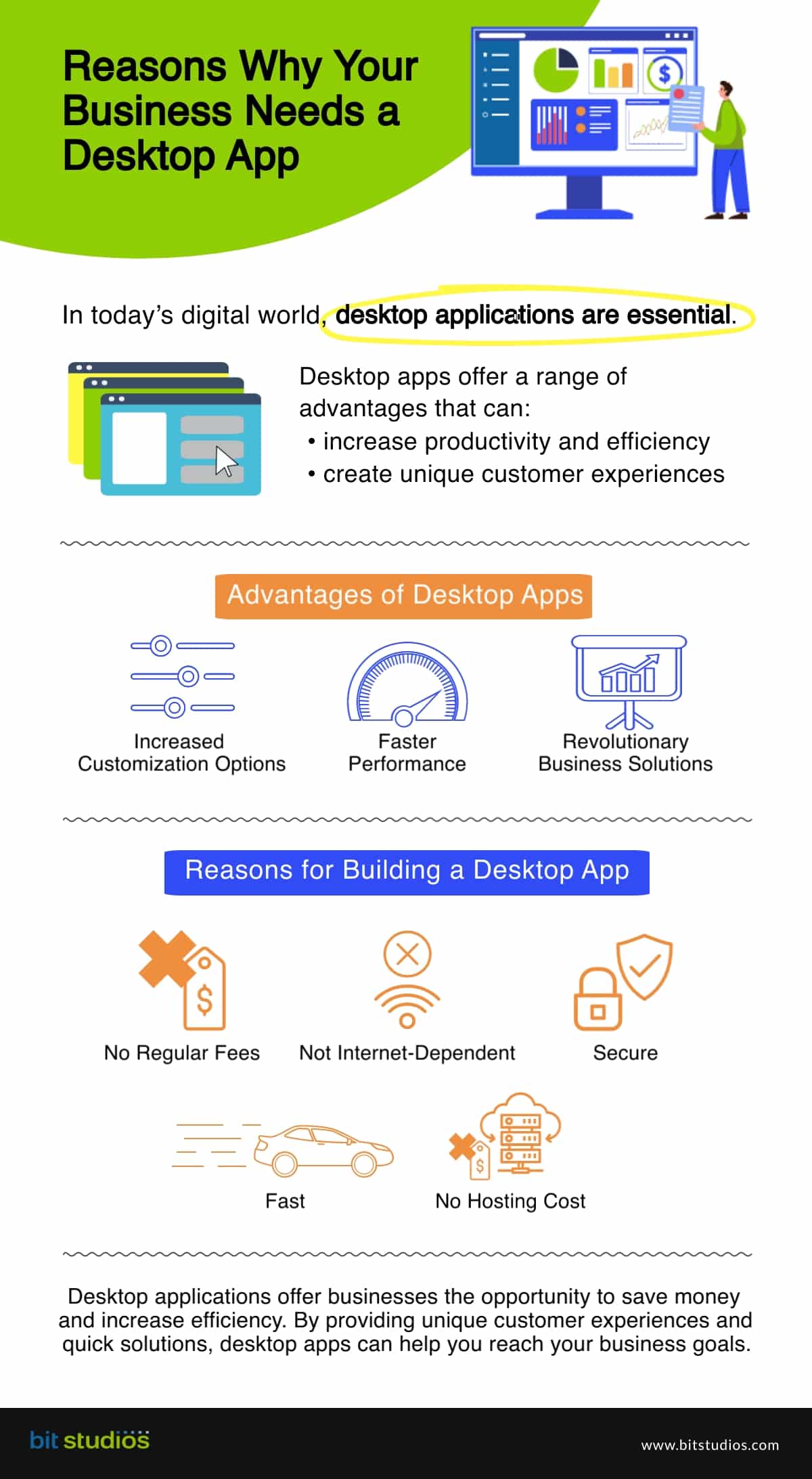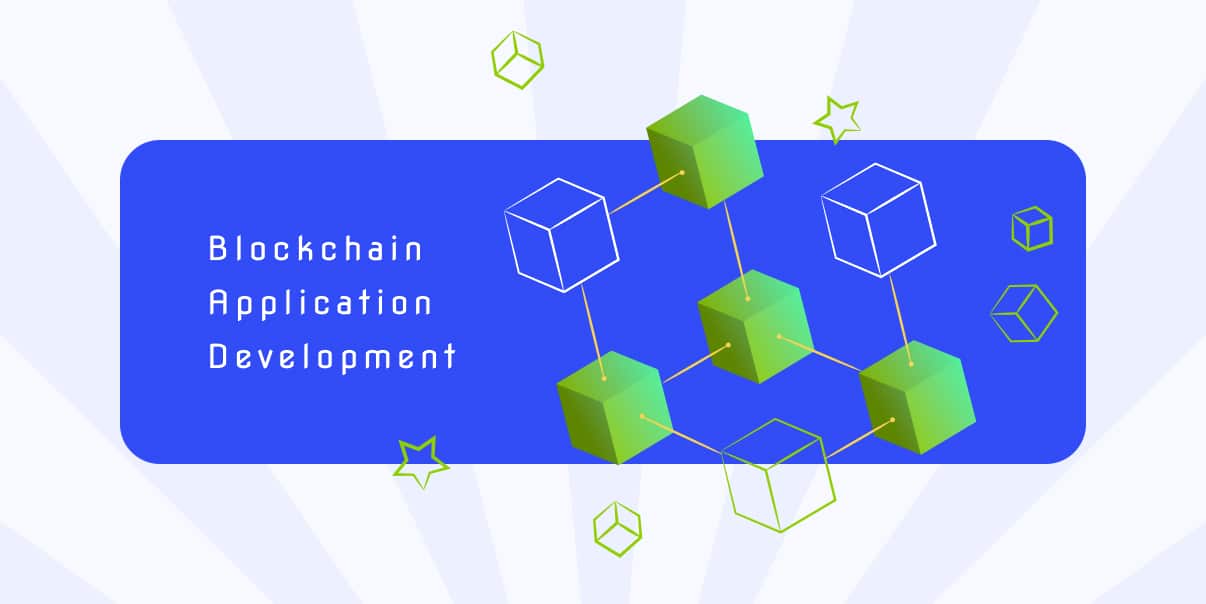What You Should Know About Desktop Application Development

Desktop application development benefits many businesses. They can use it to create powerful and unique applications tailored to their needs. Desktop apps have the potential to provide invaluable solutions for small to large enterprises.
With desktop applications, businesses of all sizes can unlock endless possibilities. This blog will explore all aspects of desktop application development solutions to help you make informed decisions and skyrocket your business.
What Is a Desktop Application?
A desktop application is a program that runs on a desktop or laptop computer. You can use a desktop app without an internet connection. Some examples of desktop apps are web browsers, word processors, media players, and gaming programs.
Unlike some cloud-based applications, you can install desktop applications on your device. You don’t need to access them through a web browser. They can also provide capabilities not available in other types of software. Desktop apps can run multiple apps simultaneously within one window. They also offer increased customization options for the user interface and faster performance.
Desktop applications offer several benefits, including more stability and reliability than cloud-based solutions. They are also faster and more efficient than web-based programs. You don’t need to re-download or update them each time you access them. Moreover, desktop applications provide increased security. You can install them on a single device, and they don’t share data with other users or the internet.
Types of Desktop Applications
There are two main types of desktop applications: native applications and cross-platform applications. Developers write native applications specifically for one platform. In contrast, cross-platform applications can run on multiple platforms. They work on Windows, Mac OSX, and Linux.
Native applications generally offer better performance and user experience. Developers design them specifically for the target platform. They can also take advantage of all the features available on the platform. Native apps have higher-resolution graphics and increased customization options.
On the other hand, cross-platform applications provide a consistent look across multiple platforms. They are more cost-effective to develop as developers only need to write them once.
Companies should consider their specific needs when deciding which application type to create. Those who require advanced features may want to opt for native applications. Companies looking for a more cost-effective solution may choose cross-platform applications.
Reasons for Building a Desktop App

In today’s digital world, desktop applications are essential. Businesses need it to stay competitive and provide customers with the best experience. Desktop apps offer a range of advantages, like increasing productivity and efficiency. They can also create unique experiences tailored to each customer’s needs.
Desktop apps provide increased customization options and faster performance. It means that they have the potential to revolutionize how companies operate. To do so, they offer robust solutions to help businesses reach their goals quickly and easily.
Are you still deciding whether to develop desktop applications for your business? Here are other reasons you should do it.
No Regular Fees
Desktop apps don’t have regular fees. There’s no recurring subscription fee to pay for your app, so you can keep it up and running for as long as you like. You can build and distribute as many desktop apps as you want. And you don’t need to worry about paying anything extra.
Not Internet-dependent
A desktop app doesn’t rely on a connection to work. Your app will always work as intended, regardless of where you go. No matter how much or little data you have or what kind of connection is available, you can access it. Desktop apps are perfect when you need to use your computer in an area with limited bandwidth.
Secure
Desktop apps are fast and safe. You can install them on your computer and run them directly from there. This way, they don’t share your sensitive information with other sites or services. Desktop apps store your data locally on your device. No one can see or access them unless they have physical access to your device.
Fast
Desktop apps are fast because the code runs directly on your computer. When you click on something in your app, it’s only milliseconds before it happens. With web apps, the request has to travel through all the layers of the internet.
And not only do desktop apps run faster than web browsers, but they load faster, too. That’s because they don’t have to load any graphics or other media files. Everything is already on your computer’s hard drive.
No Hosting Cost
Desktop apps have no hosting costs like web apps. Users can install them directly onto their devices. It eliminates additional server hardware and hosting fees.
If you’re building an enterprise-grade product, you need to host it on your servers. Of course, this is costly. But if you make a desktop rather than a web app, you can save money on hosting costs.
Desktop Application Development Frameworks
How do you start developing a desktop application? The first step is to use development frameworks that make the process easier and faster. Let’s explore some of the different types of desktop application frameworks available.
Flutter
Flutter is an open-source development framework. Google created it for developing high-performance, cross-platform desktop applications. The language it uses is Dart, a language developed by Google. Dart offers robust support for desktop and mobile platforms. Flutter helps developers create beautiful, fast, and engaging user experiences.
Electron
Electron is a cross-platform development framework. GitHub created the tool to develop desktop apps with web technologies like JavaScript, HTML, and CSS. With it, developers can create desktop software that runs on macOS, Linux, and Windows. Electron uses Node.js to allow developers to use popular web technologies in their desktop applications.
Cocoa
Cocoa is Apple’s native development framework for creating macOS apps. It uses the Objective-C programming language. Objective C helps developers build highly efficient, user-friendly desktop applications for macOS. With Cocoa, developers can craft desktop apps that integrate seamlessly with the Mac operating system.
Windows Presentation Foundation (WPF)
WPF is an ideal choice for software development on Windows platforms. Its capability to provide a comprehensive set of desktop development tools makes it outstanding. You can create powerful user interfaces with these tools.
Additionally, WPF supports vector graphics, animation, data binding, layout management, styling, and more. It has a robust library of controls and APIs. So, developers can quickly build visually stunning apps that offer users an engaging experience.
WPF integrates seamlessly with Microsoft technologies, such as DirectX and .NET frameworks. Integration capabilities make it easy to extend existing apps or develop new ones from scratch.
UWP
Universal Windows Platform (UWP) is Microsoft’s open-source desktop app development framework. Developers use it to create apps for various Windows 10 devices. You can use the apps made using UWP on PCs, tablets, phones, Microsoft HoloLens, and Xbox One. UWP apps are highly secure with advanced security features like sandboxing and encryption.
WinForms
WinForms enables developers to create Windows-based desktop software. It utilizes the NET framework. Its features include an extensive library of controls and APIs that simplify UI design, animation, data binding, navigation, and other development tasks. WinForms makes it easy for developers to create visually stunning applications.
Swing
Swing is an object-oriented framework. Oracle created it for developing cross-platform desktop applications with Java. You can use it to create powerful, highly interactive user experiences. Swing employs the Model View Controller (MVC) architecture. It allows developers to separate the application logic from the view layer and manage them independently.
There are many frameworks available for use in creating high-performance, cross-platform applications. Choosing the proper framework for your needs is essential to ensure a successful outcome.
Programming Languages for Desktop Apps
Desktop applications are integral to the computing experience. Their development requires a deep understanding of programming languages. Read on and explore the different programming languages used for desktop application development. Doing so will help you make an informed decision when selecting a language for your project.
C#
C# is an object-oriented programming language. It allows developers to create programs for macOS, Linux, and Windows operating systems. C# provides an extensive library of features such as object orientation, garbage collection, and metadata. With these features, most developers prefer this language for desktop application development. You can use C++ together with C# to enhance performance when necessary.
C++
C++ is a powerful, general-purpose programming language. It is the preferred choice for many developers due to its support for low-level operations. This programming language can create high-performance applications. It also provides an extensive library of features. C++ offers classes, objects, templates, and exceptions. These features make it easy to write clean, maintainable code.
Java
Java is a popular language for desktop app development due to its high portability. With its extensive library of features, you can create applications with less effort. You can use it with other languages, such as C++ or HTML5, to create dynamic user experiences.
Python
Python is a beginner-friendly programming language. It is well-known for its simplicity and clean syntax which is one of the reasons it’s easy to learn and use. What’s more, Python has a vast library of modules and frameworks. They greatly simplify development tasks.
JavaScript
JavaScript is an interpreted programming language. It is well-suited to developing applications with a rich user interface. Java’s object-oriented nature makes it easy to maintain complex codebases.
PHP
PHP is a modern programming language used extensively for desktop application development. It is powerful enough to build complex programs, yet it is simple enough for beginners to start. Developers also use PHP in web app development. It provides extensive libraries and functions that make development more straightforward and faster. You can use PHP with other languages, such as HTML5, CSS, and JavaScript.
Swift
Swift is a powerful, modern programming language for developing desktop applications. It provides a comprehensive library of features such as generics, protocols, and closures that make development easier and faster.
Additionally, Swift supports cross-platform development with minimal effort. It allows developers to create applications for major operating systems.
HTML 5
HTML 5 enables developers to create rich, interactive user experiences with its extensive multimedia support offline storage and drag-and-drop features. These features make HTML5 ideal for building modern desktop applications.
CSS
CSS is a styling language developers use for creating artistic user interface elements. It provides extensive features such as media queries, flexbox, and animations. These features make it easier to create visually appealing applications with minimal effort.
Conclusion
The landscape of desktop app development services is constantly changing, but that doesn’t mean it’s hard to find the right technology for your project. With various options available, deciding which is best for you can be challenging.
It’s vital to research the available options and decide which language best suits the project. With a bit of time and effort, any developer can create powerful desktop applications that you can use across multiple platforms.
But don’t worry – we’re here to help. BIT Studios has years of experience developing desktop applications. We can use our expertise to create a custom solution for your business. Contact us today and learn more about how we can help build your next desktop application.
We look forward to working with you!
We’re BIT Studios!
At BIT Studios we specialize in designing, building, shipping, and scaling beautiful, usable products with blazing-fast efficiency



